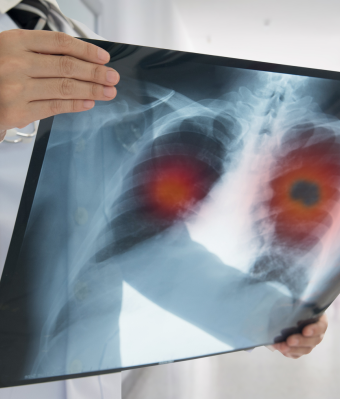Summary
Blue Toe Syndrome (BTS) is a rare vascular disorder characterized by the sudden onset of blue or purple discoloration in one or more toes.1,2 It is typically associated with the embolization of cholesterol crystals or other embolic material into small blood vessels, leading to impaired blood flow and tissue damage.2 BTS has been documented in patients taking oral anticoagulants, such as warfarin, but it remains a rare uncommon complication in this population. Here, we present a case of BTS in a patient receiving warfarin therapy, focusing on clinical presentation and management.1
Introduction
Blue Toe Syndrome, first identified in 1976 in patients taking oral blood thinners, is when one or more toes suddenly turn blue or purplish and become painful and sensitive to touch.1 The main problem in BTS is the blockage of small blood vessels, causing slow blood flow and damage to the blood vessels. Initially, the skin discoloration can be temporarily reduced by pressing on it, but later on, it doesn’t change color when pressed, indicating that red blood cells are leaking out.1,2
The most common cause of BTS is atheroembolism, including cholesterol crystal embolism (CCE). However, other factors such as heart-related embolisms (like infective endocarditis or cardiac myxoma), conditions causing thickening of the blood (like cryoglobulinemia or cold agglutinins), increased blood clotting tendencies (as seen in cancer or antiphospholipid syndrome), inflammation of blood vessels (vasculitis), and other conditions (like calciphylaxis) can also lead to BTS.2,3
Case Presentation1

Figure 1: A skin biopsy of the right big toe revealed the presence of cleft-like spaces within an artery, along with inflammation involving the tissues surrounding the blood vessel and swelling of the endothelial cells.
- A man in his early 90s came to the doctor with purple-colored and painful toes, but it was unclear when this issue had started.
- He had heart-related problems and took medications like atorvastatin, low-dose aspirin, and warfarin.
- He hadn’t undergone significant medical procedures since a heart procedure six years ago.
- When the doctor examined him, they noticed his toes were purple and tender.
- Blood tests showed that his blood’s ability to clot, measured by the INR, was much higher than normal (3.32 instead of the normal range of 0.90–1.10).
- A skin biopsy of his right big toe revealed damage to the arteries with inflammation and swelling of the inner lining of the blood vessels, which was consistent with cholesterol crystal embolism (CCE).
- An ultrasound of his heart found no blockage as a potential source of these cholesterol crystals breaking loose.
- The doctor adjusted his warfarin dose, and when he returned for a follow-up visit two months later, the purple discoloration in his toes had improved.
Description
CCE represents a rare manifestation of atherosclerosis resulting from the embolization of the contents within an atherosclerotic plaque. These contents typically consist of small cholesterol crystals and debris from the atheroma. They travel from a larger proximal artery to smaller or medium-sized distal arteries. CCE can lead to ischemia in various end organs such as the skin, kidney, gut, eye, brain, and heart.2
In cases of CCE, skin ischemia often presents as conditions like Blue Toe Syndrome (BTS) or livedo reticularis, which are crucial for diagnosing CCE, as observed in the current case. The underlying pathophysiology of CCE is believed to involve plaque rupture, which can occur spontaneously, due to trauma, or even iatrogenically (particularly during cardiovascular procedures). This rupture subsequently results in mechanical obstruction and triggers an inflammatory response.1,3
Moreover, there is a hypothesis that anticoagulation therapy may be a risk factor for plaque hemorrhage, plaque rupture, and subsequent development of CCE. However, it’s important to note that a direct causal relationship between anticoagulant use and CCE has not been firmly established. Further research is required to determine whether exceeding the therapeutic INR range increases the risk of CCE.4
Discussion
Blue Toe Syndrome (BTS) results from the embolization of cholesterol crystals or other embolic material into small blood vessels, leading to impaired blood flow and tissue damage. Although it has been reported in patients receiving oral anticoagulants, such as warfarin, this case illustrates the rare occurrence of BTS in such patients.1,3
In this case, the primary mechanism underlying BTS was cholesterol crystal embolization (CCE), confirmed through skin biopsy findings. CCE can occur spontaneously or result from various underlying conditions, including atherosclerosis, and may lead to unpredictable embolic events.1,4
Managing BTS in patients receiving anticoagulant therapy presents a clinical challenge. As was done in this case, adjusting anticoagulant dosages is critical to maintaining a balance between preventing thromboembolic events and minimizing the risk of further embolization.3,4
Conclusion
This case report underscores the importance of considering cholesterol crystal embolization (CCE) as a potential cause of Blue Toe Syndrome (BTS) in patients taking warfarin or other anticoagulants. Prompt recognition, appropriate diagnostic evaluation, and adjustment of anticoagulant therapy are essential to mitigate the risk of further embolic events and improve patient outcomes. Healthcare providers should remain vigilant for BTS in patients with acute toe discoloration, especially those with a cardiovascular disease history and anticoagulant use.1,2,3,4
References
- Kano Y, Shigehara Y. Blue toe syndrome caused by cholesterol crystal embolization in a patient with warfarin use. BMJ Case Report 2023;16: e257927. doi:10.1136/bcr-2023-257927
- Karmody AM, Powers SR, Monaco VJ, Leather RP. “Blue toe” syndrome. An indication for limb salvage surgery. The Archives of Surgery. 1976 Nov;111(11):1263-8. doi: 10.1001/archsurg.1976.01360290097015. PMID: 985075.
- Hirschmann JV, Raugi GJ. Blue (or purple) toe syndrome. Journal of the American Academy of Dermatology. 2009 Jan;60(1):1-20; quiz 21-2. doi: 10.1016/j.jaad.2008.09.038. PMID: 19103358.
- O’Keeffe ST, Woods BO, Breslin DJ, Tsapatsaris NP. Blue toe syndrome. Causes and management. The Archives of Internal Medicine. 1992 Nov;152(11):2197-202. PMID: 1444678.



